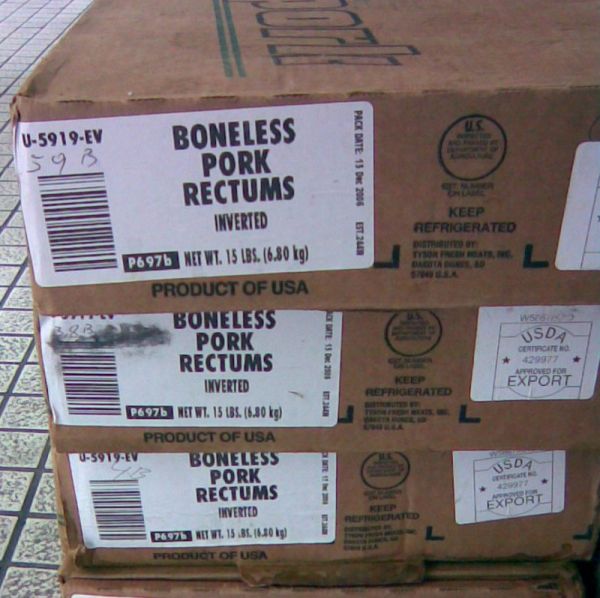Just in!!! (8/18/ca 4:00pm): Re the below, please balance, in the interest of objectivity, my posting of this piece (Boneless Pork Rectums) with an article kindly Facebooked by MP at.
***
With all the babble about the State Department's laudable "culinary initiative" (what isn't an initiative -- especially a supposedly "new" one [check your Latin] -- at Foggy Bottom these days, even when dealing with the most elementary human act, eating, existing since even before the stone age), I thought the below (provided by a Facebook friend) might be of interest to those who think proper digestion has something to do with successful diplomacy.Question: Will the Pork Rectums (what the abbreviation PR really stands for) be exhibited at the upcoming Milan World's Fair -- in which the USA will take part -- and which is dedicated in part to the pleasure of eating well, at least as I understand the purpose of the exhibit?
Should the USA display its pork rectums? On only one condition, and here I am an American superpatriot: so long as the French agree to display their foie gras :)
***
For Sale: Boneless Port Rectums (Inverted)
(Photo: 500CBFan)
This pallet of delicious pork rectums was spotted outside of a dumpling shop in Taipei, Taiwan. Please note that it is a product of the great republic. Despite complaints to the contary, American workers can still produce goods sought across world.
It appears that pork rectums must be properly deboned and inverted before they become sellable. These can be made into dumplings. Here in the South, we deep fry pork intestines and call them chitlins. Alternatively, we may use them as sausage casings. To my knowledge, these practices do not include the actual rectum portion. Perhaps the people of Taiwan prize quality American pork rectums so highly that they price domestic consumers out of the market.
How many pork rectums are present in this picture? How many would fit into a standard shipping container? W.M. Briggs, a statistician, learned that just one South Korean food company imports 2-3 shipping containers full of American pork rectums a month. He crunches the numbers:
The 20-foot container is a standard size; we have all seen these containers on the highway. They measure 20′ x 8′ x 8.5′ feet. The volume is 1,360 cubic feet.
We only need one more piece of information. The size of the average, deboned, inverted pig’s rectum is two feet long, and 2 inches wide. For the purposes of this calculation, we can assume that the rectum is a parallelepiped, which is to say, a rectangular box of size 2′ x 0.167′ x 0.167′ feet. A standard rectum thus takes up 0.056 cubic feet. We’ll ignore packing considerations for now and imagine that we’re trying to stuff as many rectums as we can into a container. This calculation, which will represent an upper bound, is easy: we have 1,360 available cubic feet, and each rectums takes up 0.056 cubic feet.
That makes about 25,000 rectums per container. Using the universal principle “one pig, one rectum”, this makes it 25,000 pigs slaughtered per container. Of course, packaging adds bulk, so that the actual number of rectums that can be transported per container must be less. A figure of 20% to 30% increase per rectum seems reasonable. That is, each dry rectum, considering the plastic, dry ice, cardboard, etc., is like 1.2 to 1.3 packaged rectum.Now, those Koreans are importing 2 to 3 of those containers every month. Pick the middle figure. That makes 30 containers a year, just going to this one company. That gives a grand total of between 560,000 to 610,000 rectums per year sailing across the high seas on their way to Korea.
This means that each takes up about 0.067 to 0.072 cubic feet per rectum. That gives us a low of about 18,500 to a high of around 20,000 rectums per container.
-via David Thompson
P.S. Shouldn't these actually be labeled as boneless pork recta? I cannot confirm it, but I think that rectum is a second declension noun.
No comments:
Post a Comment